Advanced Financial Accounting Report: IFRS vs. GAAP
VerifiedAdded on 2021/05/27
|12
|2817
|37
Report
AI Summary
This advanced financial accounting report examines key aspects of financial reporting, focusing on the qualitative characteristics of financial statements, the differences between IFRS and GAAP, and the implications of asset revaluation. The report analyzes the importance of understandability, relevance, reliability, and comparability in financial disclosures, highlighting how current IFRS practices may not fully satisfy these characteristics. It also explores the Public Interest Theory, Capture Theory, and Economic Interest Theory in the context of regulatory frameworks. Furthermore, the report discusses the complexities and controversies surrounding asset revaluation, comparing IFRS and GAAP approaches and considering the impact on financial data, stakeholder decisions, and compliance. The report highlights the challenges and uncertainties associated with revaluation, explaining why management might be hesitant to revalue assets.

Paraphrase This Document
Need a fresh take? Get an instant paraphrase of this document with our AI Paraphraser

1
By student name
Professor
University
Date: 25 April 2018.
1 | P a g e
By student name
Professor
University
Date: 25 April 2018.
1 | P a g e
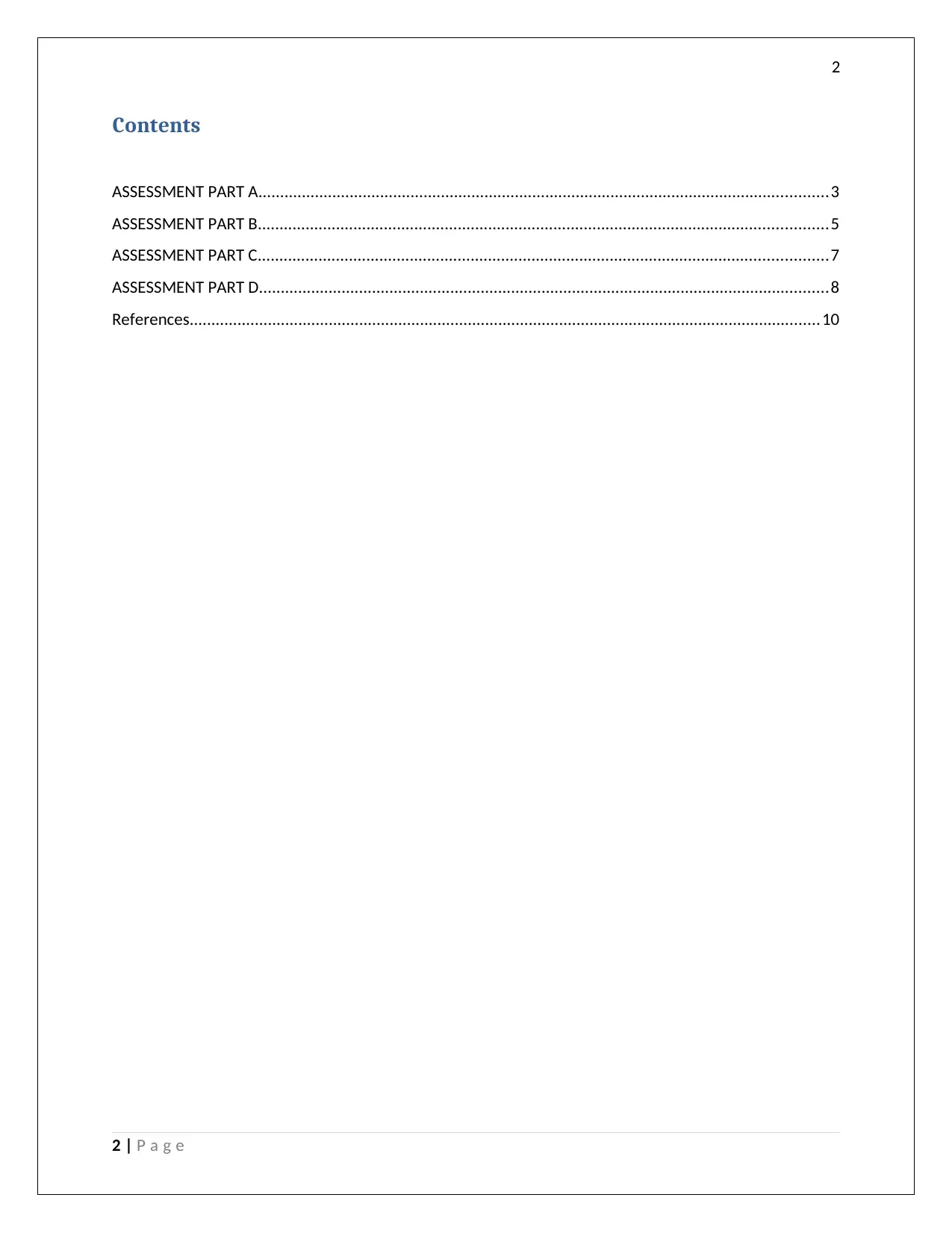
2
Contents
ASSESSMENT PART A...................................................................................................................................3
ASSESSMENT PART B...................................................................................................................................5
ASSESSMENT PART C...................................................................................................................................7
ASSESSMENT PART D...................................................................................................................................8
References.................................................................................................................................................10
2 | P a g e
Contents
ASSESSMENT PART A...................................................................................................................................3
ASSESSMENT PART B...................................................................................................................................5
ASSESSMENT PART C...................................................................................................................................7
ASSESSMENT PART D...................................................................................................................................8
References.................................................................................................................................................10
2 | P a g e
⊘ This is a preview!⊘
Do you want full access?
Subscribe today to unlock all pages.

Trusted by 1+ million students worldwide
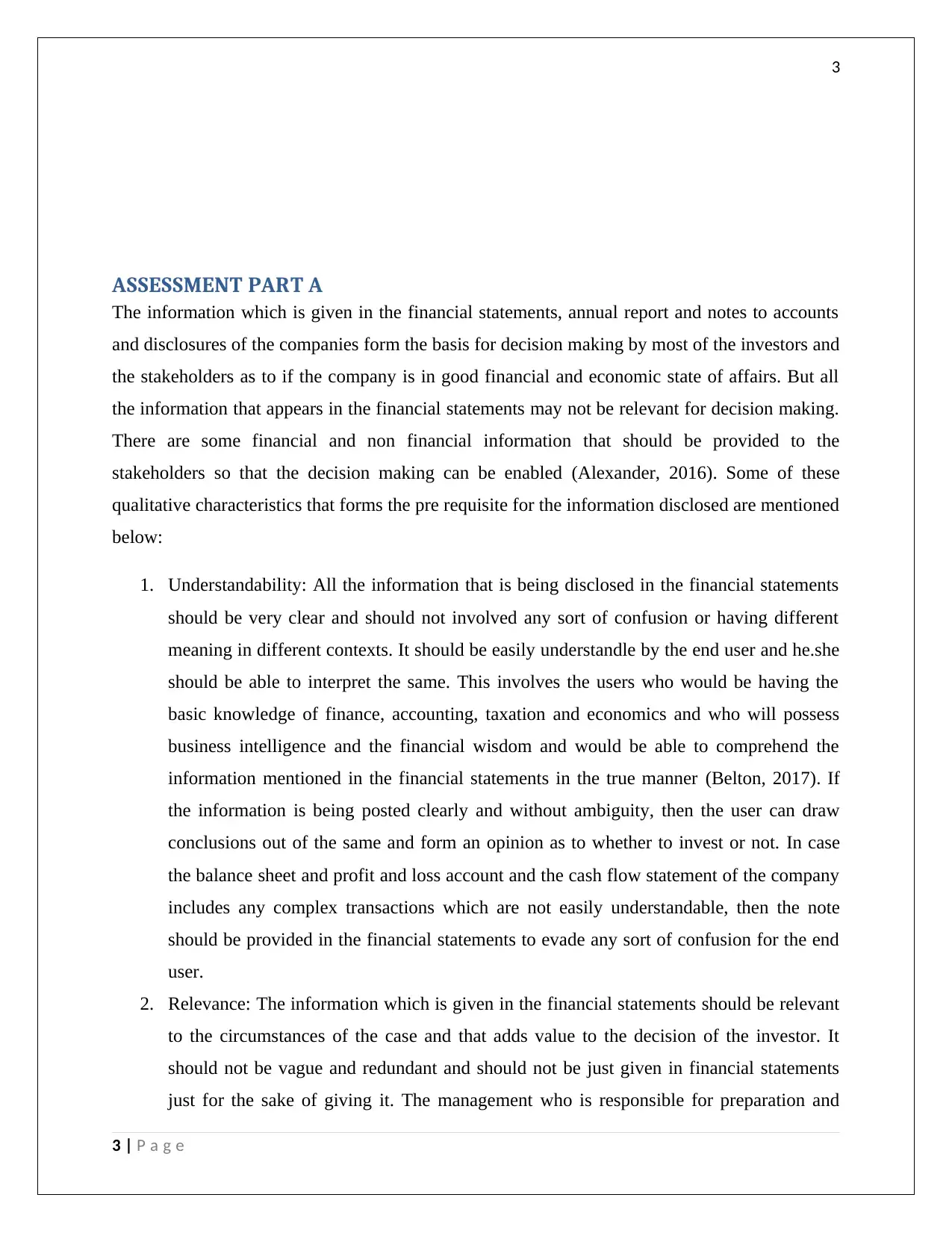
3
ASSESSMENT PART A
The information which is given in the financial statements, annual report and notes to accounts
and disclosures of the companies form the basis for decision making by most of the investors and
the stakeholders as to if the company is in good financial and economic state of affairs. But all
the information that appears in the financial statements may not be relevant for decision making.
There are some financial and non financial information that should be provided to the
stakeholders so that the decision making can be enabled (Alexander, 2016). Some of these
qualitative characteristics that forms the pre requisite for the information disclosed are mentioned
below:
1. Understandability: All the information that is being disclosed in the financial statements
should be very clear and should not involved any sort of confusion or having different
meaning in different contexts. It should be easily understandle by the end user and he.she
should be able to interpret the same. This involves the users who would be having the
basic knowledge of finance, accounting, taxation and economics and who will possess
business intelligence and the financial wisdom and would be able to comprehend the
information mentioned in the financial statements in the true manner (Belton, 2017). If
the information is being posted clearly and without ambiguity, then the user can draw
conclusions out of the same and form an opinion as to whether to invest or not. In case
the balance sheet and profit and loss account and the cash flow statement of the company
includes any complex transactions which are not easily understandable, then the note
should be provided in the financial statements to evade any sort of confusion for the end
user.
2. Relevance: The information which is given in the financial statements should be relevant
to the circumstances of the case and that adds value to the decision of the investor. It
should not be vague and redundant and should not be just given in financial statements
just for the sake of giving it. The management who is responsible for preparation and
3 | P a g e
ASSESSMENT PART A
The information which is given in the financial statements, annual report and notes to accounts
and disclosures of the companies form the basis for decision making by most of the investors and
the stakeholders as to if the company is in good financial and economic state of affairs. But all
the information that appears in the financial statements may not be relevant for decision making.
There are some financial and non financial information that should be provided to the
stakeholders so that the decision making can be enabled (Alexander, 2016). Some of these
qualitative characteristics that forms the pre requisite for the information disclosed are mentioned
below:
1. Understandability: All the information that is being disclosed in the financial statements
should be very clear and should not involved any sort of confusion or having different
meaning in different contexts. It should be easily understandle by the end user and he.she
should be able to interpret the same. This involves the users who would be having the
basic knowledge of finance, accounting, taxation and economics and who will possess
business intelligence and the financial wisdom and would be able to comprehend the
information mentioned in the financial statements in the true manner (Belton, 2017). If
the information is being posted clearly and without ambiguity, then the user can draw
conclusions out of the same and form an opinion as to whether to invest or not. In case
the balance sheet and profit and loss account and the cash flow statement of the company
includes any complex transactions which are not easily understandable, then the note
should be provided in the financial statements to evade any sort of confusion for the end
user.
2. Relevance: The information which is given in the financial statements should be relevant
to the circumstances of the case and that adds value to the decision of the investor. It
should not be vague and redundant and should not be just given in financial statements
just for the sake of giving it. The management who is responsible for preparation and
3 | P a g e
Paraphrase This Document
Need a fresh take? Get an instant paraphrase of this document with our AI Paraphraser
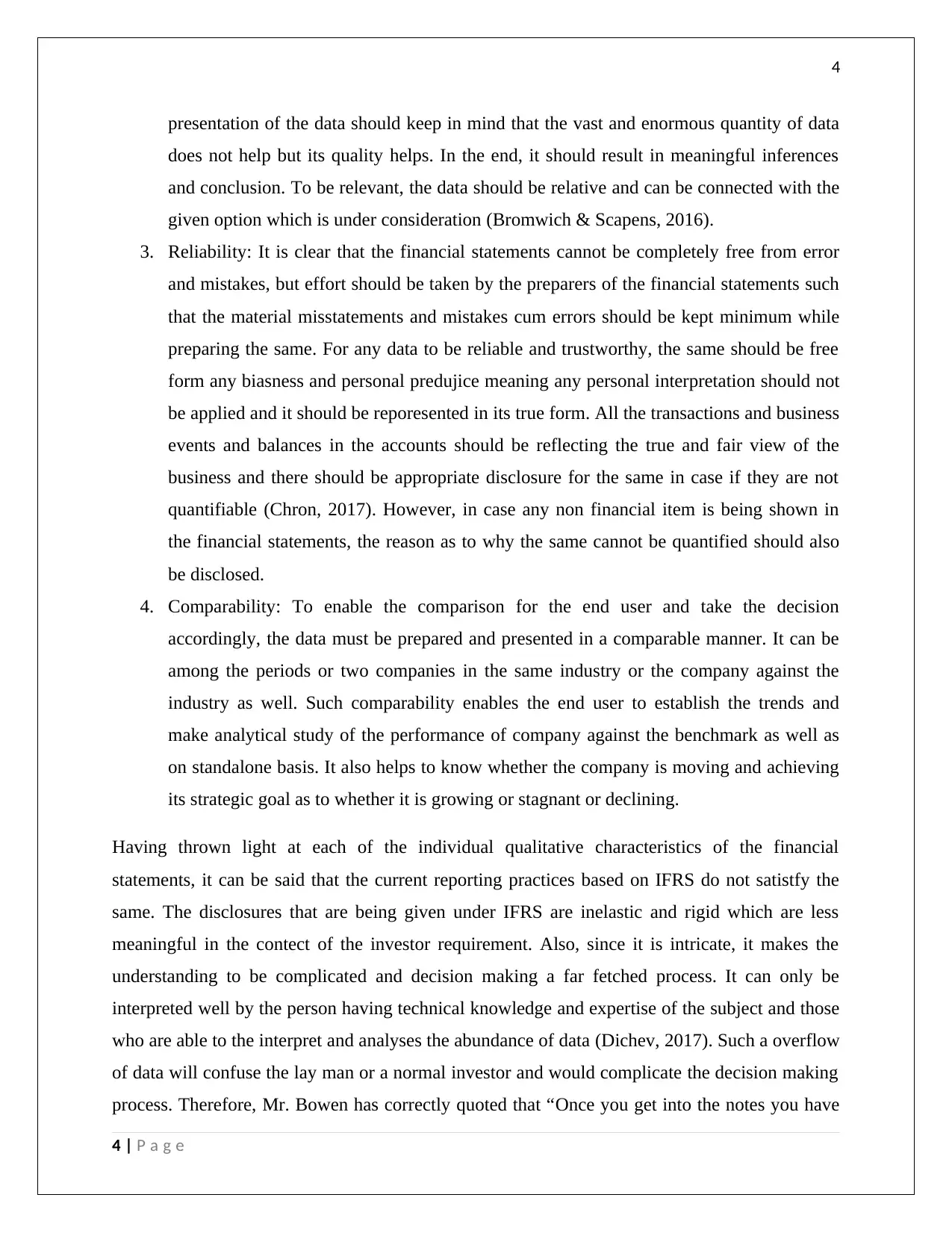
4
presentation of the data should keep in mind that the vast and enormous quantity of data
does not help but its quality helps. In the end, it should result in meaningful inferences
and conclusion. To be relevant, the data should be relative and can be connected with the
given option which is under consideration (Bromwich & Scapens, 2016).
3. Reliability: It is clear that the financial statements cannot be completely free from error
and mistakes, but effort should be taken by the preparers of the financial statements such
that the material misstatements and mistakes cum errors should be kept minimum while
preparing the same. For any data to be reliable and trustworthy, the same should be free
form any biasness and personal predujice meaning any personal interpretation should not
be applied and it should be reporesented in its true form. All the transactions and business
events and balances in the accounts should be reflecting the true and fair view of the
business and there should be appropriate disclosure for the same in case if they are not
quantifiable (Chron, 2017). However, in case any non financial item is being shown in
the financial statements, the reason as to why the same cannot be quantified should also
be disclosed.
4. Comparability: To enable the comparison for the end user and take the decision
accordingly, the data must be prepared and presented in a comparable manner. It can be
among the periods or two companies in the same industry or the company against the
industry as well. Such comparability enables the end user to establish the trends and
make analytical study of the performance of company against the benchmark as well as
on standalone basis. It also helps to know whether the company is moving and achieving
its strategic goal as to whether it is growing or stagnant or declining.
Having thrown light at each of the individual qualitative characteristics of the financial
statements, it can be said that the current reporting practices based on IFRS do not satistfy the
same. The disclosures that are being given under IFRS are inelastic and rigid which are less
meaningful in the contect of the investor requirement. Also, since it is intricate, it makes the
understanding to be complicated and decision making a far fetched process. It can only be
interpreted well by the person having technical knowledge and expertise of the subject and those
who are able to the interpret and analyses the abundance of data (Dichev, 2017). Such a overflow
of data will confuse the lay man or a normal investor and would complicate the decision making
process. Therefore, Mr. Bowen has correctly quoted that “Once you get into the notes you have
4 | P a g e
presentation of the data should keep in mind that the vast and enormous quantity of data
does not help but its quality helps. In the end, it should result in meaningful inferences
and conclusion. To be relevant, the data should be relative and can be connected with the
given option which is under consideration (Bromwich & Scapens, 2016).
3. Reliability: It is clear that the financial statements cannot be completely free from error
and mistakes, but effort should be taken by the preparers of the financial statements such
that the material misstatements and mistakes cum errors should be kept minimum while
preparing the same. For any data to be reliable and trustworthy, the same should be free
form any biasness and personal predujice meaning any personal interpretation should not
be applied and it should be reporesented in its true form. All the transactions and business
events and balances in the accounts should be reflecting the true and fair view of the
business and there should be appropriate disclosure for the same in case if they are not
quantifiable (Chron, 2017). However, in case any non financial item is being shown in
the financial statements, the reason as to why the same cannot be quantified should also
be disclosed.
4. Comparability: To enable the comparison for the end user and take the decision
accordingly, the data must be prepared and presented in a comparable manner. It can be
among the periods or two companies in the same industry or the company against the
industry as well. Such comparability enables the end user to establish the trends and
make analytical study of the performance of company against the benchmark as well as
on standalone basis. It also helps to know whether the company is moving and achieving
its strategic goal as to whether it is growing or stagnant or declining.
Having thrown light at each of the individual qualitative characteristics of the financial
statements, it can be said that the current reporting practices based on IFRS do not satistfy the
same. The disclosures that are being given under IFRS are inelastic and rigid which are less
meaningful in the contect of the investor requirement. Also, since it is intricate, it makes the
understanding to be complicated and decision making a far fetched process. It can only be
interpreted well by the person having technical knowledge and expertise of the subject and those
who are able to the interpret and analyses the abundance of data (Dichev, 2017). Such a overflow
of data will confuse the lay man or a normal investor and would complicate the decision making
process. Therefore, Mr. Bowen has correctly quoted that “Once you get into the notes you have
4 | P a g e
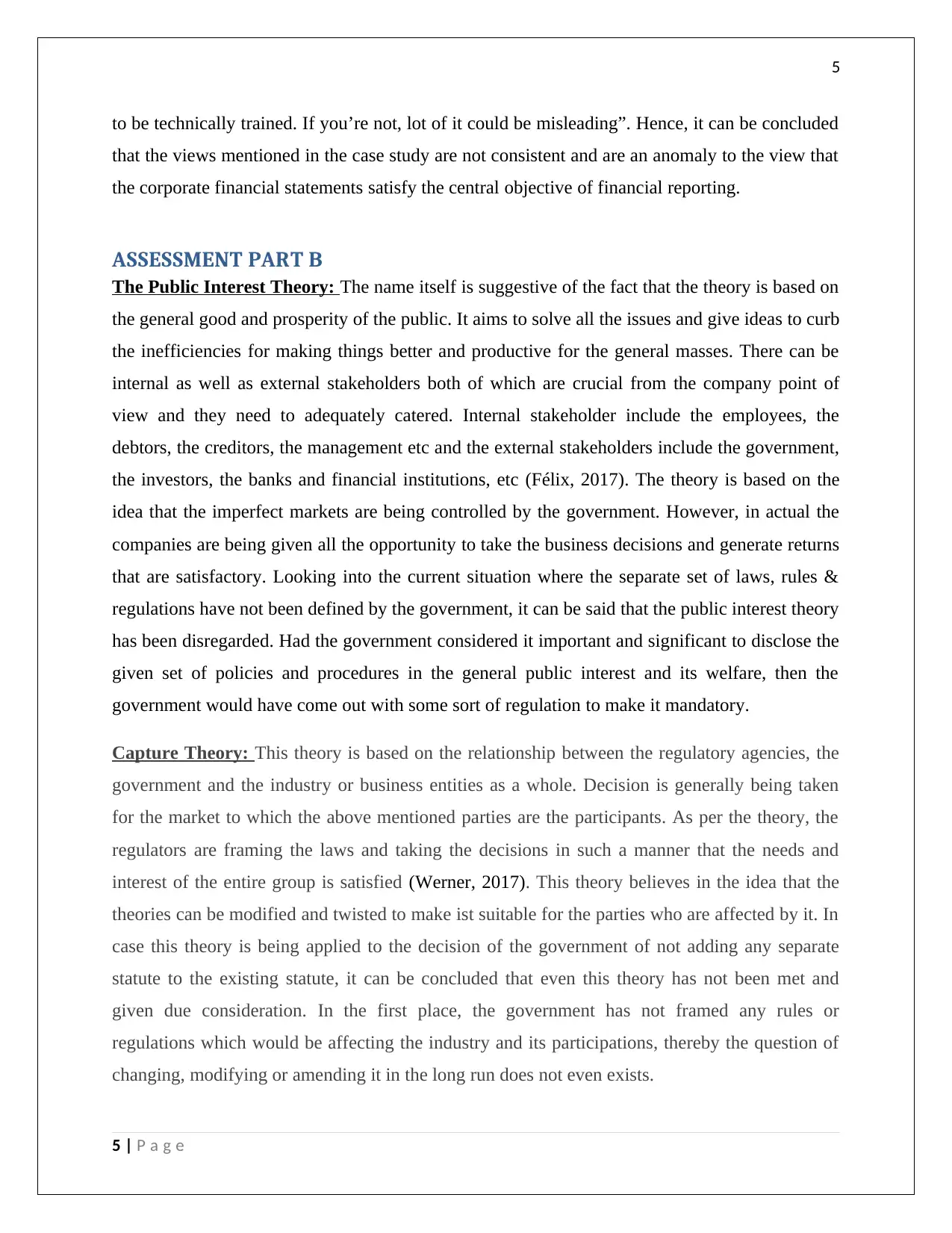
5
to be technically trained. If you’re not, lot of it could be misleading”. Hence, it can be concluded
that the views mentioned in the case study are not consistent and are an anomaly to the view that
the corporate financial statements satisfy the central objective of financial reporting.
ASSESSMENT PART B
The Public Interest Theory: The name itself is suggestive of the fact that the theory is based on
the general good and prosperity of the public. It aims to solve all the issues and give ideas to curb
the inefficiencies for making things better and productive for the general masses. There can be
internal as well as external stakeholders both of which are crucial from the company point of
view and they need to adequately catered. Internal stakeholder include the employees, the
debtors, the creditors, the management etc and the external stakeholders include the government,
the investors, the banks and financial institutions, etc (Félix, 2017). The theory is based on the
idea that the imperfect markets are being controlled by the government. However, in actual the
companies are being given all the opportunity to take the business decisions and generate returns
that are satisfactory. Looking into the current situation where the separate set of laws, rules &
regulations have not been defined by the government, it can be said that the public interest theory
has been disregarded. Had the government considered it important and significant to disclose the
given set of policies and procedures in the general public interest and its welfare, then the
government would have come out with some sort of regulation to make it mandatory.
Capture Theory: This theory is based on the relationship between the regulatory agencies, the
government and the industry or business entities as a whole. Decision is generally being taken
for the market to which the above mentioned parties are the participants. As per the theory, the
regulators are framing the laws and taking the decisions in such a manner that the needs and
interest of the entire group is satisfied (Werner, 2017). This theory believes in the idea that the
theories can be modified and twisted to make ist suitable for the parties who are affected by it. In
case this theory is being applied to the decision of the government of not adding any separate
statute to the existing statute, it can be concluded that even this theory has not been met and
given due consideration. In the first place, the government has not framed any rules or
regulations which would be affecting the industry and its participations, thereby the question of
changing, modifying or amending it in the long run does not even exists.
5 | P a g e
to be technically trained. If you’re not, lot of it could be misleading”. Hence, it can be concluded
that the views mentioned in the case study are not consistent and are an anomaly to the view that
the corporate financial statements satisfy the central objective of financial reporting.
ASSESSMENT PART B
The Public Interest Theory: The name itself is suggestive of the fact that the theory is based on
the general good and prosperity of the public. It aims to solve all the issues and give ideas to curb
the inefficiencies for making things better and productive for the general masses. There can be
internal as well as external stakeholders both of which are crucial from the company point of
view and they need to adequately catered. Internal stakeholder include the employees, the
debtors, the creditors, the management etc and the external stakeholders include the government,
the investors, the banks and financial institutions, etc (Félix, 2017). The theory is based on the
idea that the imperfect markets are being controlled by the government. However, in actual the
companies are being given all the opportunity to take the business decisions and generate returns
that are satisfactory. Looking into the current situation where the separate set of laws, rules &
regulations have not been defined by the government, it can be said that the public interest theory
has been disregarded. Had the government considered it important and significant to disclose the
given set of policies and procedures in the general public interest and its welfare, then the
government would have come out with some sort of regulation to make it mandatory.
Capture Theory: This theory is based on the relationship between the regulatory agencies, the
government and the industry or business entities as a whole. Decision is generally being taken
for the market to which the above mentioned parties are the participants. As per the theory, the
regulators are framing the laws and taking the decisions in such a manner that the needs and
interest of the entire group is satisfied (Werner, 2017). This theory believes in the idea that the
theories can be modified and twisted to make ist suitable for the parties who are affected by it. In
case this theory is being applied to the decision of the government of not adding any separate
statute to the existing statute, it can be concluded that even this theory has not been met and
given due consideration. In the first place, the government has not framed any rules or
regulations which would be affecting the industry and its participations, thereby the question of
changing, modifying or amending it in the long run does not even exists.
5 | P a g e
⊘ This is a preview!⊘
Do you want full access?
Subscribe today to unlock all pages.

Trusted by 1+ million students worldwide
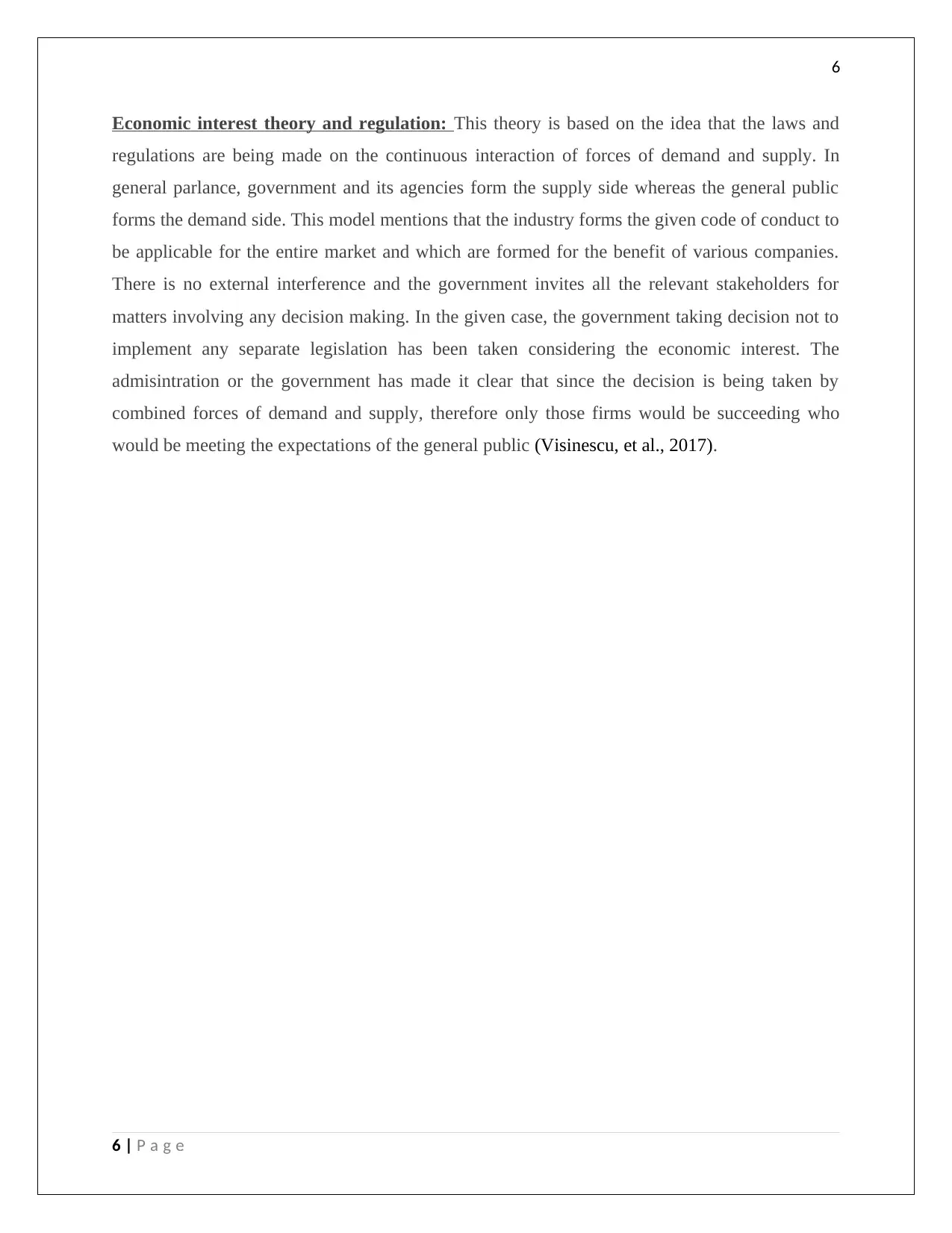
6
Economic interest theory and regulation: This theory is based on the idea that the laws and
regulations are being made on the continuous interaction of forces of demand and supply. In
general parlance, government and its agencies form the supply side whereas the general public
forms the demand side. This model mentions that the industry forms the given code of conduct to
be applicable for the entire market and which are formed for the benefit of various companies.
There is no external interference and the government invites all the relevant stakeholders for
matters involving any decision making. In the given case, the government taking decision not to
implement any separate legislation has been taken considering the economic interest. The
admisintration or the government has made it clear that since the decision is being taken by
combined forces of demand and supply, therefore only those firms would be succeeding who
would be meeting the expectations of the general public (Visinescu, et al., 2017).
6 | P a g e
Economic interest theory and regulation: This theory is based on the idea that the laws and
regulations are being made on the continuous interaction of forces of demand and supply. In
general parlance, government and its agencies form the supply side whereas the general public
forms the demand side. This model mentions that the industry forms the given code of conduct to
be applicable for the entire market and which are formed for the benefit of various companies.
There is no external interference and the government invites all the relevant stakeholders for
matters involving any decision making. In the given case, the government taking decision not to
implement any separate legislation has been taken considering the economic interest. The
admisintration or the government has made it clear that since the decision is being taken by
combined forces of demand and supply, therefore only those firms would be succeeding who
would be meeting the expectations of the general public (Visinescu, et al., 2017).
6 | P a g e
Paraphrase This Document
Need a fresh take? Get an instant paraphrase of this document with our AI Paraphraser
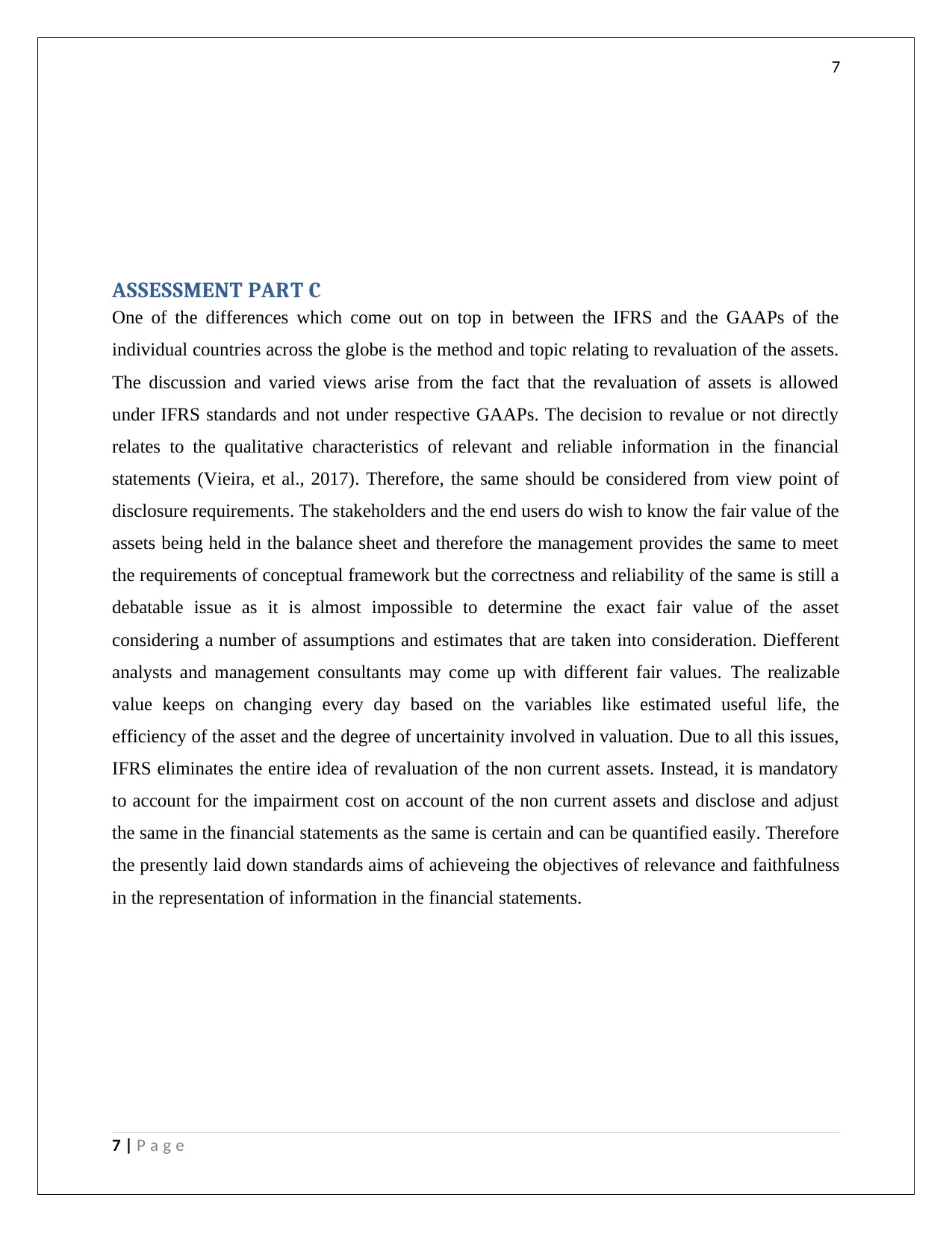
7
ASSESSMENT PART C
One of the differences which come out on top in between the IFRS and the GAAPs of the
individual countries across the globe is the method and topic relating to revaluation of the assets.
The discussion and varied views arise from the fact that the revaluation of assets is allowed
under IFRS standards and not under respective GAAPs. The decision to revalue or not directly
relates to the qualitative characteristics of relevant and reliable information in the financial
statements (Vieira, et al., 2017). Therefore, the same should be considered from view point of
disclosure requirements. The stakeholders and the end users do wish to know the fair value of the
assets being held in the balance sheet and therefore the management provides the same to meet
the requirements of conceptual framework but the correctness and reliability of the same is still a
debatable issue as it is almost impossible to determine the exact fair value of the asset
considering a number of assumptions and estimates that are taken into consideration. Diefferent
analysts and management consultants may come up with different fair values. The realizable
value keeps on changing every day based on the variables like estimated useful life, the
efficiency of the asset and the degree of uncertainity involved in valuation. Due to all this issues,
IFRS eliminates the entire idea of revaluation of the non current assets. Instead, it is mandatory
to account for the impairment cost on account of the non current assets and disclose and adjust
the same in the financial statements as the same is certain and can be quantified easily. Therefore
the presently laid down standards aims of achieveing the objectives of relevance and faithfulness
in the representation of information in the financial statements.
7 | P a g e
ASSESSMENT PART C
One of the differences which come out on top in between the IFRS and the GAAPs of the
individual countries across the globe is the method and topic relating to revaluation of the assets.
The discussion and varied views arise from the fact that the revaluation of assets is allowed
under IFRS standards and not under respective GAAPs. The decision to revalue or not directly
relates to the qualitative characteristics of relevant and reliable information in the financial
statements (Vieira, et al., 2017). Therefore, the same should be considered from view point of
disclosure requirements. The stakeholders and the end users do wish to know the fair value of the
assets being held in the balance sheet and therefore the management provides the same to meet
the requirements of conceptual framework but the correctness and reliability of the same is still a
debatable issue as it is almost impossible to determine the exact fair value of the asset
considering a number of assumptions and estimates that are taken into consideration. Diefferent
analysts and management consultants may come up with different fair values. The realizable
value keeps on changing every day based on the variables like estimated useful life, the
efficiency of the asset and the degree of uncertainity involved in valuation. Due to all this issues,
IFRS eliminates the entire idea of revaluation of the non current assets. Instead, it is mandatory
to account for the impairment cost on account of the non current assets and disclose and adjust
the same in the financial statements as the same is certain and can be quantified easily. Therefore
the presently laid down standards aims of achieveing the objectives of relevance and faithfulness
in the representation of information in the financial statements.
7 | P a g e
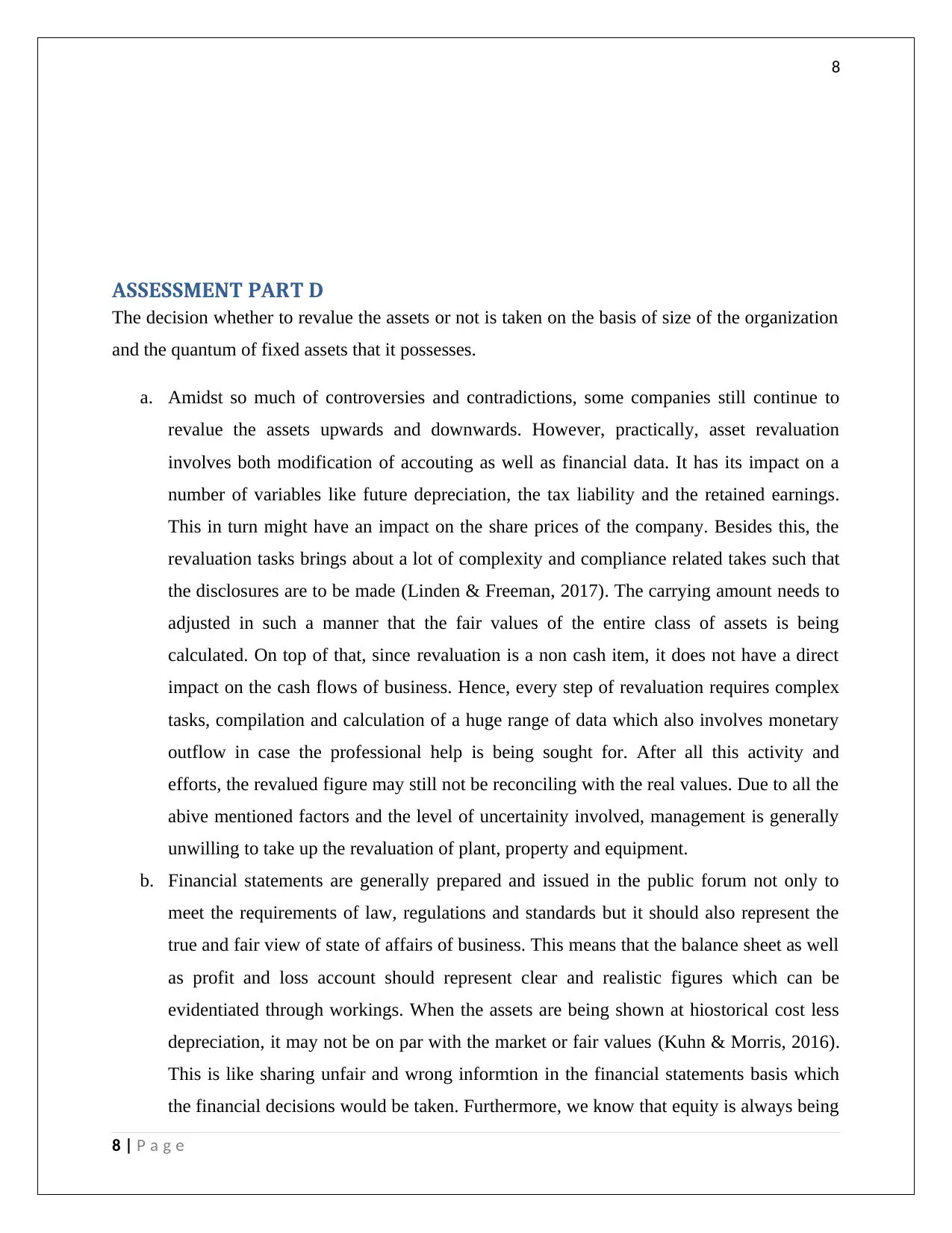
8
ASSESSMENT PART D
The decision whether to revalue the assets or not is taken on the basis of size of the organization
and the quantum of fixed assets that it possesses.
a. Amidst so much of controversies and contradictions, some companies still continue to
revalue the assets upwards and downwards. However, practically, asset revaluation
involves both modification of accouting as well as financial data. It has its impact on a
number of variables like future depreciation, the tax liability and the retained earnings.
This in turn might have an impact on the share prices of the company. Besides this, the
revaluation tasks brings about a lot of complexity and compliance related takes such that
the disclosures are to be made (Linden & Freeman, 2017). The carrying amount needs to
adjusted in such a manner that the fair values of the entire class of assets is being
calculated. On top of that, since revaluation is a non cash item, it does not have a direct
impact on the cash flows of business. Hence, every step of revaluation requires complex
tasks, compilation and calculation of a huge range of data which also involves monetary
outflow in case the professional help is being sought for. After all this activity and
efforts, the revalued figure may still not be reconciling with the real values. Due to all the
abive mentioned factors and the level of uncertainity involved, management is generally
unwilling to take up the revaluation of plant, property and equipment.
b. Financial statements are generally prepared and issued in the public forum not only to
meet the requirements of law, regulations and standards but it should also represent the
true and fair view of state of affairs of business. This means that the balance sheet as well
as profit and loss account should represent clear and realistic figures which can be
evidentiated through workings. When the assets are being shown at hiostorical cost less
depreciation, it may not be on par with the market or fair values (Kuhn & Morris, 2016).
This is like sharing unfair and wrong informtion in the financial statements basis which
the financial decisions would be taken. Furthermore, we know that equity is always being
8 | P a g e
ASSESSMENT PART D
The decision whether to revalue the assets or not is taken on the basis of size of the organization
and the quantum of fixed assets that it possesses.
a. Amidst so much of controversies and contradictions, some companies still continue to
revalue the assets upwards and downwards. However, practically, asset revaluation
involves both modification of accouting as well as financial data. It has its impact on a
number of variables like future depreciation, the tax liability and the retained earnings.
This in turn might have an impact on the share prices of the company. Besides this, the
revaluation tasks brings about a lot of complexity and compliance related takes such that
the disclosures are to be made (Linden & Freeman, 2017). The carrying amount needs to
adjusted in such a manner that the fair values of the entire class of assets is being
calculated. On top of that, since revaluation is a non cash item, it does not have a direct
impact on the cash flows of business. Hence, every step of revaluation requires complex
tasks, compilation and calculation of a huge range of data which also involves monetary
outflow in case the professional help is being sought for. After all this activity and
efforts, the revalued figure may still not be reconciling with the real values. Due to all the
abive mentioned factors and the level of uncertainity involved, management is generally
unwilling to take up the revaluation of plant, property and equipment.
b. Financial statements are generally prepared and issued in the public forum not only to
meet the requirements of law, regulations and standards but it should also represent the
true and fair view of state of affairs of business. This means that the balance sheet as well
as profit and loss account should represent clear and realistic figures which can be
evidentiated through workings. When the assets are being shown at hiostorical cost less
depreciation, it may not be on par with the market or fair values (Kuhn & Morris, 2016).
This is like sharing unfair and wrong informtion in the financial statements basis which
the financial decisions would be taken. Furthermore, we know that equity is always being
8 | P a g e
⊘ This is a preview!⊘
Do you want full access?
Subscribe today to unlock all pages.

Trusted by 1+ million students worldwide

9
shown at the fair market value and so not showing fixed assets at fair value will give
wrong results for the debt equity ratio. This has a direct impact on the borrowing powers
of the company.
c. The impact not to revalue the assets on the shareholder’s wealth is dependent on internal
and external factors. It is true that it gives an unrealistic picture of accounts but its direct
impact on shareholders cannot be measured as it does not results in the actual inflow or
outflow of cash. Even though this does not have a direct impact on profitability but the
revaluation balance when added to retained earnings might give and impression that the
shareholders’ wealth has increased but the same is not true. The same is the case when
there is a downward revaluation. The reaction of the market to this change does not
results in value creation or destruction to the shareholder’s wealth (Sithole, et al., 2017).
9 | P a g e
shown at the fair market value and so not showing fixed assets at fair value will give
wrong results for the debt equity ratio. This has a direct impact on the borrowing powers
of the company.
c. The impact not to revalue the assets on the shareholder’s wealth is dependent on internal
and external factors. It is true that it gives an unrealistic picture of accounts but its direct
impact on shareholders cannot be measured as it does not results in the actual inflow or
outflow of cash. Even though this does not have a direct impact on profitability but the
revaluation balance when added to retained earnings might give and impression that the
shareholders’ wealth has increased but the same is not true. The same is the case when
there is a downward revaluation. The reaction of the market to this change does not
results in value creation or destruction to the shareholder’s wealth (Sithole, et al., 2017).
9 | P a g e
Paraphrase This Document
Need a fresh take? Get an instant paraphrase of this document with our AI Paraphraser
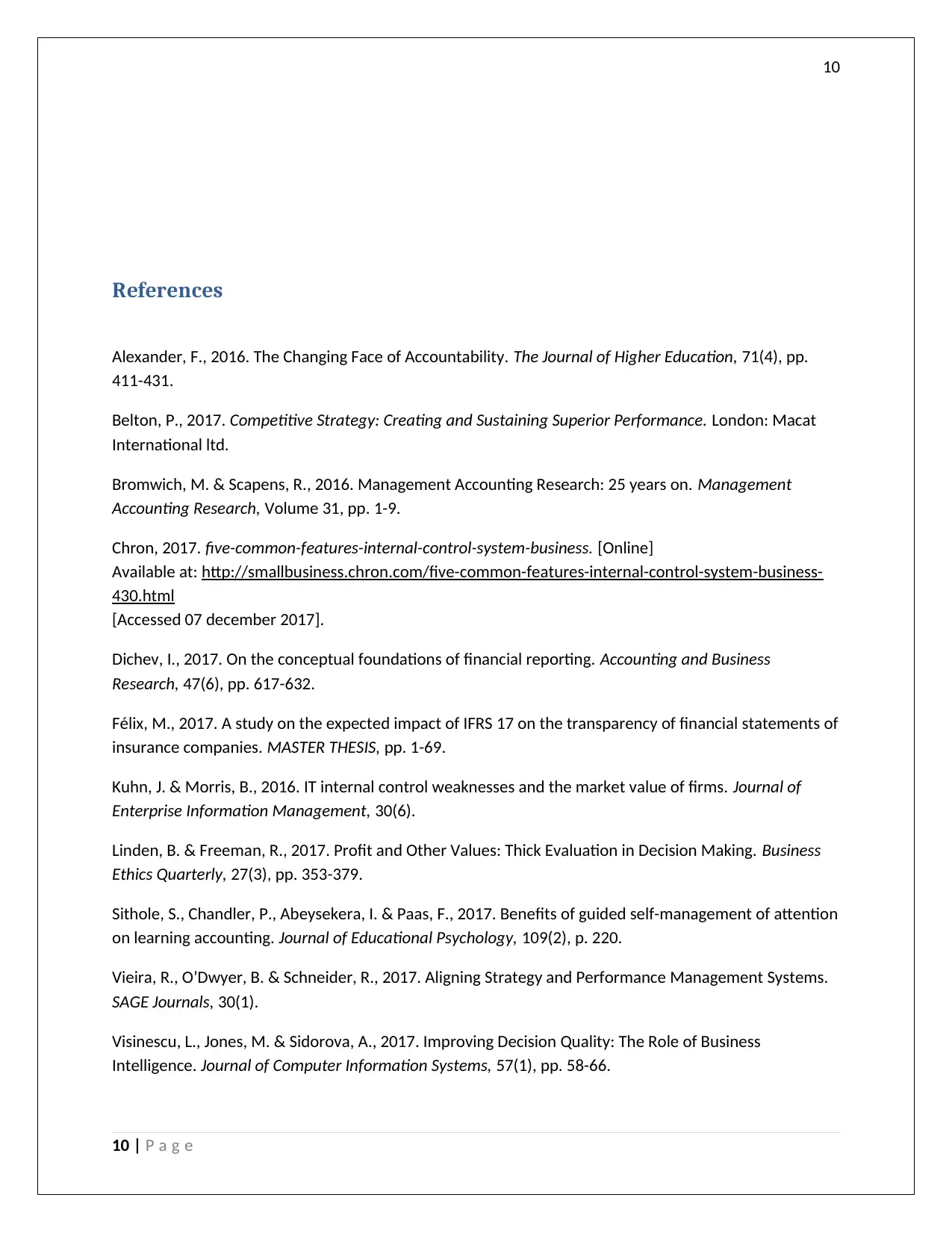
10
References
Alexander, F., 2016. The Changing Face of Accountability. The Journal of Higher Education, 71(4), pp.
411-431.
Belton, P., 2017. Competitive Strategy: Creating and Sustaining Superior Performance. London: Macat
International ltd.
Bromwich, M. & Scapens, R., 2016. Management Accounting Research: 25 years on. Management
Accounting Research, Volume 31, pp. 1-9.
Chron, 2017. five-common-features-internal-control-system-business. [Online]
Available at: http://smallbusiness.chron.com/five-common-features-internal-control-system-business-
430.html
[Accessed 07 december 2017].
Dichev, I., 2017. On the conceptual foundations of financial reporting. Accounting and Business
Research, 47(6), pp. 617-632.
Félix, M., 2017. A study on the expected impact of IFRS 17 on the transparency of financial statements of
insurance companies. MASTER THESIS, pp. 1-69.
Kuhn, J. & Morris, B., 2016. IT internal control weaknesses and the market value of firms. Journal of
Enterprise Information Management, 30(6).
Linden, B. & Freeman, R., 2017. Profit and Other Values: Thick Evaluation in Decision Making. Business
Ethics Quarterly, 27(3), pp. 353-379.
Sithole, S., Chandler, P., Abeysekera, I. & Paas, F., 2017. Benefits of guided self-management of attention
on learning accounting. Journal of Educational Psychology, 109(2), p. 220.
Vieira, R., O’Dwyer, B. & Schneider, R., 2017. Aligning Strategy and Performance Management Systems.
SAGE Journals, 30(1).
Visinescu, L., Jones, M. & Sidorova, A., 2017. Improving Decision Quality: The Role of Business
Intelligence. Journal of Computer Information Systems, 57(1), pp. 58-66.
10 | P a g e
References
Alexander, F., 2016. The Changing Face of Accountability. The Journal of Higher Education, 71(4), pp.
411-431.
Belton, P., 2017. Competitive Strategy: Creating and Sustaining Superior Performance. London: Macat
International ltd.
Bromwich, M. & Scapens, R., 2016. Management Accounting Research: 25 years on. Management
Accounting Research, Volume 31, pp. 1-9.
Chron, 2017. five-common-features-internal-control-system-business. [Online]
Available at: http://smallbusiness.chron.com/five-common-features-internal-control-system-business-
430.html
[Accessed 07 december 2017].
Dichev, I., 2017. On the conceptual foundations of financial reporting. Accounting and Business
Research, 47(6), pp. 617-632.
Félix, M., 2017. A study on the expected impact of IFRS 17 on the transparency of financial statements of
insurance companies. MASTER THESIS, pp. 1-69.
Kuhn, J. & Morris, B., 2016. IT internal control weaknesses and the market value of firms. Journal of
Enterprise Information Management, 30(6).
Linden, B. & Freeman, R., 2017. Profit and Other Values: Thick Evaluation in Decision Making. Business
Ethics Quarterly, 27(3), pp. 353-379.
Sithole, S., Chandler, P., Abeysekera, I. & Paas, F., 2017. Benefits of guided self-management of attention
on learning accounting. Journal of Educational Psychology, 109(2), p. 220.
Vieira, R., O’Dwyer, B. & Schneider, R., 2017. Aligning Strategy and Performance Management Systems.
SAGE Journals, 30(1).
Visinescu, L., Jones, M. & Sidorova, A., 2017. Improving Decision Quality: The Role of Business
Intelligence. Journal of Computer Information Systems, 57(1), pp. 58-66.
10 | P a g e
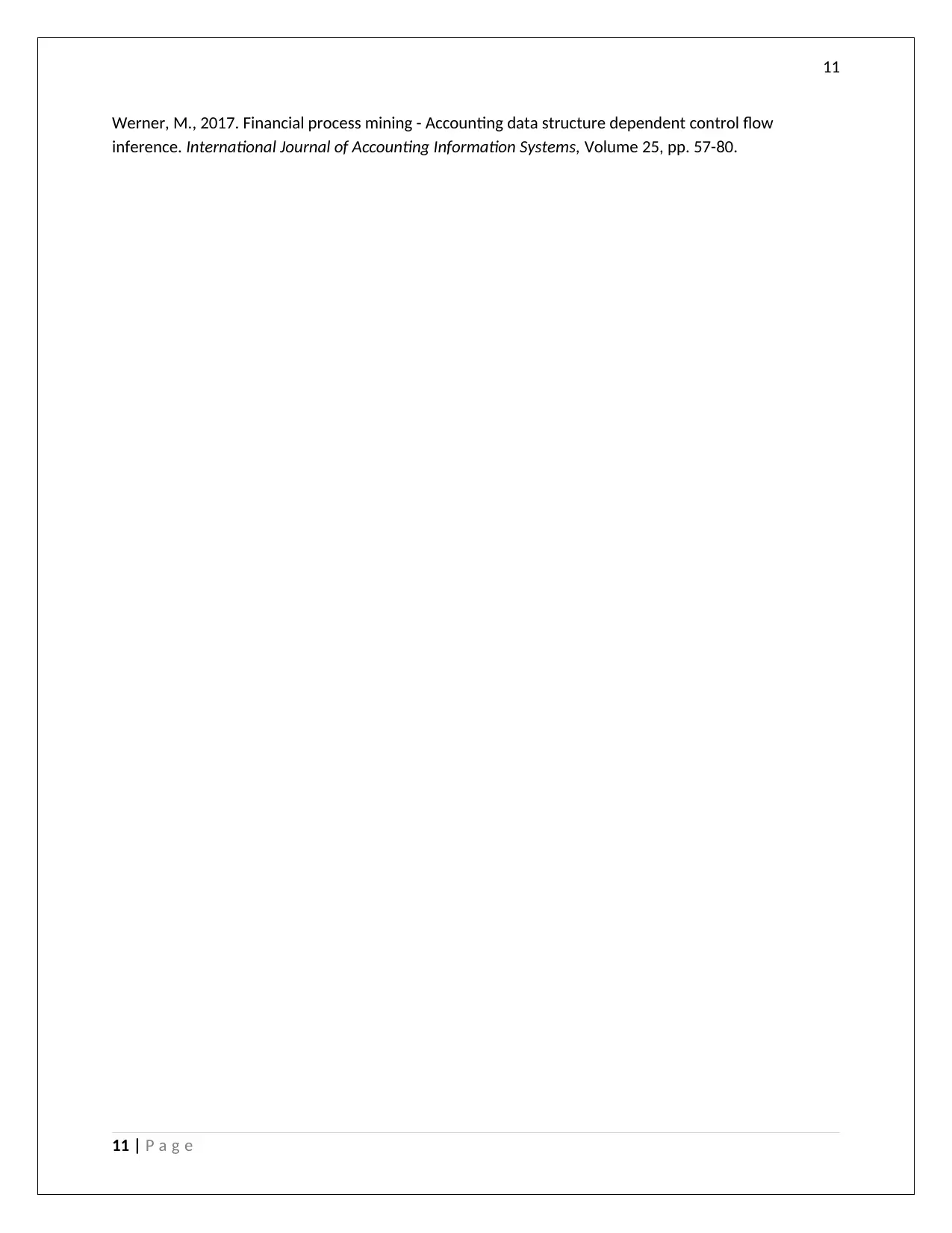
11
Werner, M., 2017. Financial process mining - Accounting data structure dependent control flow
inference. International Journal of Accounting Information Systems, Volume 25, pp. 57-80.
11 | P a g e
Werner, M., 2017. Financial process mining - Accounting data structure dependent control flow
inference. International Journal of Accounting Information Systems, Volume 25, pp. 57-80.
11 | P a g e
⊘ This is a preview!⊘
Do you want full access?
Subscribe today to unlock all pages.

Trusted by 1+ million students worldwide
1 out of 12
Related Documents
Your All-in-One AI-Powered Toolkit for Academic Success.
+13062052269
info@desklib.com
Available 24*7 on WhatsApp / Email
![[object Object]](/_next/static/media/star-bottom.7253800d.svg)
Unlock your academic potential
Copyright © 2020–2025 A2Z Services. All Rights Reserved. Developed and managed by ZUCOL.





